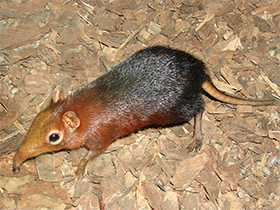Genus Giant Sengis Rhynchocyon
The black and rufous elephant shrew (or black and rufous sengi) Rhynchocyon petersi
This amazing animal has striking contrasting black and brownish-red colouration. The black and rufous sengi is the largest representative of the elephant shrews; its body length varies from 24 to 31 cm and it weighs about 0.5 kg. A very long tail of the black and rufous sengi ranges between 19 and 26 cm in length. Long, thin legs make these shrews speedy runners though their hind legs are not as much longer than the front ones as in other elephant shrews. Each foot of both front and hind legs has four toes as the black and rufous sengis lack first toe. The black and rufous sengi’s snout is highly elongated, the ears are relatively small and rounded. The species name commemorates Wilhelm Peters, German naturalist and explorer who set out for a scientific voyage to southeast-Africa from 1842 to 1848. He visited the major Mozambican settlements along the coast to collect, describe and, after returning home, to systematically classify the collected animal specimens and to disseminate his findings through articles in scientific journals.
The fur of the black and rufous sengis is short and fairly coarse. They have multi-coloured pelage, their front half is covered in reddish-brown fur, while their back half is covered in black fur. The tal is covered in short hairs and may be white in some colour types. Nasal bones are relatively short and wide; frontal bones are very large. This shrew has 34-36 teeth, with incisors in upper jaw being absent or rudimental; upper canines are large.
Black and rufous elephant shrews are found only in Africa. They are native to Tanzania and south-eastern Kenya. These shrews occur in evergreen and semi-deciduous forests in the coastal areas, dense woodlands, coral rag scrub, and abandoned and overgrown agricultural lands. The black and rufous elephant shrew is mostly active during the day. The animals spend their life on the forest floor, foraging through leaf litter in search of insects in the day, and staying in the nests that they build of the leaf during nights. Black and rufous sengis are monogamous; they occupy their home range for lifetime. They mainly feed on invertebrates including spiders, ants, termites, and terrestrial molluscs, but occasionally may eat small mammals, birds, and bird eggs. Breeding occurs all year round. Females give birth to one or two offspring and may produce 4-5 litters per year. Young are weaned at the age of two weeks; they become independent at the age or two to three weeks. Lifespan of the black and rufous sengis in the wild is 4-5 years.











































